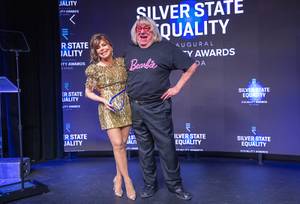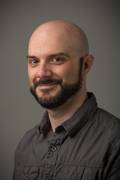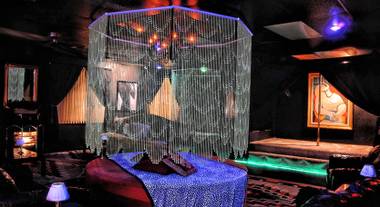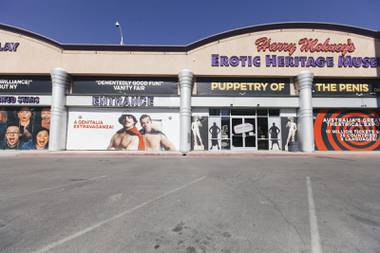It took 16 drafts and over four decades archiving, but historian and Nevada State Museum Director Dennis McBride has finally published the story of the LGBT experience in Nevada. From that epic effort comes Out of the Neon Closet: Queer Community in the Silver State, a nearly epic account itself that begins with statehood and a virulently homophobic government, then focuses largely on the strides made within a growing local LGBT community over the last 40 years, when the author himself was fighting for equality. It swells with historical information and context, complemented by detailed—and almost always engrossing—anecdotes and accounts McBride exhaustively compiled over the years.
For any LGBT person living in the Valley, Out of the Neon Closet is a must read, as it abounds with the sort of perspective that explains both the frustrations (the organizational infighting, the difficulty of inspiring community engagement) and the underdog pluck (the lobbying and activism that resulted in legislative victories, the resilience and resourcefulness of a community in survival mode) that has marked Las Vegas’ queer experience. The service McBride has done for the local LGBT community with his enormous archive—and now its published narrative—should never be undervalued.
For those outside the community, its historical sweep, its overlap with both Nevadan politics and Las Vegas culture, and its pull-no-punches honesty—McBride is unafraid to criticize ignorant politicians, a relentlessly intolerant Mormon church, the state’s hypocritical libertarianism and even fellow gay Las Vegans—make the book alluring, too. Most importantly, Out of the Neon Closet is essential reading so all people can truly understand the fear, hatred, alienation and literal danger so many people endured, from the era of the sodomy law to the 1980s AIDS crisis, which must never be forgotten or repeated. McBride talks about all that and more below.
Did the book really take you 20 years to write? Really, longer than that. I started building the [physical] archive in the early 1970s while struggling with coming out, and there were no resources. Libraries had no books. I had to depend on articles and papers and magazines I subscribed to. I started building and building it in 1983 when I’d been involved in Nevadans for Human Rights.
Before I could start getting in depth on the subject, I needed a first-hand archive, so I started doing oral histories. Ultimately, I did 60. Most people are starting with archives when writing a book like this. I had to create the archive to write it from. Strictly speaking, I’ve been writing the book for 20 years but building it took 40, and I’m still building it.
It would follow that you might be the only person qualified to properly document the history of LGBT Nevada. In 1994, there was a guy I met on the last Act-Up demonstration picket line [named] Bruce Adams. And his brother was Brent Adams, who had a read article about me called “Growing Up Gay in Boulder City” and wanted to meet me. We started a romantic relationship, the last one I had. When I showed him the archive, he said, “You have to write the book, you're the only one that can do it.” I never thought about that, but he gave me the idea. I realized that yes, I was the only one that could do it because of the archive that kept track of the community.
You begin the book with the grueling stories of those who suffered the consequences of Nevada’s sodomy law, which stayed on the books from 1861 to 1993. It’s a stark beginning. It’s why I call it the dark ages. It’s the history you won’t find easily. It’s very stark because in those early days, it’s a history of sex and persecution and prosecution, and it is brutal and dark. But that’s where we began. How could I not start there? It’s the truth.
Was it emotionally overwhelming to research all those sodomy convictions and the lives the law ruined? Yeah. You probably wouldn't know it, but I’m a really emotional guy. But in writing a book like this, I couldn't afford to be so and not write about something I found out. These are my people, this is my tribe and this is what happened. Reading about what happened to these poor men in the 1910s and 1930s, it was heartbreaking. There was one case, Thomas Owen, who left a prison diary complaining about never being taught anything about [homosexuality], and if they had taught sex education, maybe people wouldn't make the same mistakes that he did. You could have written that in 2016 if you were going to school in the Clark County School District.
I have a very personal connection to the [Former Lt. Governor Fred] Alward case. Richard Ham, who was [Alward’s] lover in the 1930s...ended up in Boulder City where his parents owned a grocery store. They owned a small house with a little casita in the back and I was just born in January 1955, and my parents were trying to find a place in Boulder City to live. They approached Dick Ham and said, “Could we rent this casita?” He said, “It’s too small.” Fifty years later, I tracked this man down, and I got the story out of him. We established a rapport...The irony of the situation was that he denied us a place and all these years later, I became a dear friend of his. I brought him out of the closet when he was in his 80s. I took him to see Brokeback Mountain; we cried and cried like a couple of little girls. It was actually delightful. But I got this story out of him—it's one of the most important stories in Nevada history. He’s dead now and I miss him terribly. I had a personal stake in a lot of ultimately what I wrote in the book.
Was it hard to write about history or organizations in which you participated? Logistically, it’s very different. I’m writing this history and referring to all these people I’ve interviewed—what do I do when I’m involved as well? I think I worked my way around it. I referred to myself as I was someone else and then referenced my own journals as another resource. I also had to be very careful—and I don’t know how successful I was—in keeping myself out of the narrative. First person doesn’t work within the narrative. I had to pretend I was referencing someone else.
It certainly seems that for most of the state’s history, the LGBT community was the hunted, even after the sodomy law was repealed. That came in 1993. For sure we were still hunted and maligned—and we carried on. But that whole series on legislative victories [covers] the 1990s and up until [2000’s Nevada Marriage Amendment] Question 2—and to be honest, when the sodomy law was repealed in 1993, it was an amazing feat because the legislature did it on its own without a court order, and we were the only state that did that.
The legislation that made the biggest [impact on the LGBT community] was the Nevada Employment Non-Discrimination Bill, AB 311...It really made us more equal at that point than even repealing the sodomy law. You don't f*ck with people’s lives, firing them like that. I think in some 20-odd states you can still do that [because] there’s no federal law against it.
The Review Journal seemed to take particular glee in outing and shaming LGBT Las Vegans—also well after the fall of the sodomy law. Oh, always. Surprisingly, I think they were on our side on Question 2. They thought it was dreadful.
The real nadir of the Review Journal's malignant attitude toward the gay community came in 1994, right after sodomy law had been repealed. Oregon Citizens Alliance started the Nevada Citizens Alliance and tried to get a petition effort to pass the Minority Status and Child Protection Act…all the homophobic types piled on [including] that horrible American Independent Party that the R-J included in an advertising supplement. It was beyond the pale, the horrible things they said about the gay community…that oral sex is the same as swallowing raw human blood—really terrible, almost pornographic things. A number of newspapers included that supplement. The Reno Gazette Journal and the Sun did not, but the R-J did, and I think they were very surprised at the outpouring of animosity against them. They lost thousands of subscriptions, and we were picketing them. After that, the R-J was very circumspect in how it dealt with the gay community. It became more supportive of us.
It seems particularly frustrating that UNLV seemed like such a homophobic campus. Was is something about the culture of the campus, or just culture at large? I think it was the culture of the campus. I do have to say, on one hand, there was a lot of animosity towards the gay community. President [Robert C.] Maxson was a bastard. But [President Pat] Goodall before him was great. I write about the homophobic things that happened in the 1990s, but I was surprised when I went back to do the index how much support [the university] had given the community in many ways. It had offered itself as a venue for organizational events. They were the venue for the first gay Pride event, the Human Rights Seminar. They were the venue for quite a number of women’s events. That was going on all the time. If you look at it from a larger broader perspective, the university was more supportive.
When I went to school there as an undergrad I was very out and open. That took a lot of people aback. In 1979, the Creative Arts Symposium, where we brought Allen Ginsberg and Peter Orlovsky ... [me and] the guy who put this one on, we were having a romantic affair and were open [about it] on campus. They didn't really hurt or bother us, but it was obvious [the students] were not used to seeing that. In my journals, it has all of that background and first-hand experience and information. I had to use them. That’s where my journals come in and out of the narrative.
Most of the book takes place in Las Vegas. Are there fewer records about gay history and figures in other Nevada cities? Is there not a Dennis McBride to develop a historical archive in Reno? On one hand, I’m proud of what I did, but no, I don’t pay attention [to] Reno and Carson City as would be possible to do with an archive...It certainly deserves it. I think I did give them their due, especially [with regard to] the sodomy law and the Minority Status and Child Protection Act, and I’m happy with the chapter on the Reno Gay Rodeo. More should be done there, though.
What were your favorite parts to research and/or write, that may have even motivated you further in the process? The whole chapter about [same-sex] marriage, that struck me to my core. It shattered me. It changed my life and radicalized me against the Mormon church. It is the most perfect example of political hypocrisy, of the most political venality and religious tyranny. I’ve very, very proud of that chapter…it gave me the biggest buzz.
But all the millions of dollars spent and the emotional currency came to absolutely nothing because now we can be married like anyone else. And I fought and was out there, trying to convince people, “Stop this bullsh*t, it’s horrible.” I was ignored; we all were. In the end, none of it had to happen.
You routinely write of the struggles to get LGBT locals to organize and participate on any level for the sake of their own community. How much better has it gotten? It’s much, much better. Back in the 1970s, when the Nevadans For Human Rights was founded, that was the very nascent [LGBT] community and that was tough. It got better in the late 1970s and early 1980s. I don’t know how much further we would have gotten if not for the AIDS epidemic, which cut us at the knees. But after we got through it, which was sort of bookended by the repeal of the sodomy law, we learned a lot. And it got better and better. It goes up and down, but the trend is a much larger involvement.
As we became more and more assimilated into [the mainstream], we’ve picked up many more straight allies, which you can’t get by without… One of the earliest activists, Christie Young, was straight, and she was on television to promote the first gay Pride because none of the lesbians would. She was a straight activist who made a tremendous difference. We should reciprocate. We should be fighting for women's and trans issues and people of color. We should be side by side with them. The most recent example of this was the [march on the Strip after the] Orlando Massacre. You look at the pictures, every kind of person was there, and I know many of them weren’t gay, but straight, and of many colors. I looked it afterward as a great apotheosis to everything we've been building toward.
Why do gay people disagree and fight with one another—especially within LGBT organizations—so much? It feels like there’s tradition of it. I think it is less so now, but it’s also not particular to the gay community. Very marginalized communities go through the same thing—the African American community, the Jewish community—legendary infighting that distracts everyone from the main point. I had to be able to document it more thoroughly because I was a part of [the organizational infighting]. It’s not uncommon in marginalized communities because they’ve lived with a sense of siege all their lives. This sense of defensiveness carries on through…and sometimes it’s another gay person that pushes their buttons and leads to wasted animosity.
You already knew so much about the gay community here early in the project. Did you have any big discoveries or perhaps a general revelation about it by the end? It’s hard to say. My perspective over these many decades has changed. When you grow older, you become less politically acquainted. You still fight and you're still angry, but you become, as you know people and yourself better—which comes with age—you become more understanding. I found when I went back to chapters I wrote very early, I was very pugnacious and pungent about people and what they did, but as I got older, I softened toward them, and gave them a little more benefit of the doubt.
For example, I didn’t cut [former Lt. Governor] Myron Leavitt any slack. He was an absolute bastard with what he said about the [Reno] gay rodeo. But as I did more research and interviews, [I discovered] that the apple of his eye, his favorite child, Tom, was gay. I thought, here’s Myron Leavitt, saying horrible things about gays before he knew his son was gay, [he’s] a very prominent Mormon and politician. It’s his religion and generation talking... Suddenly, he finds out his favorite child is gay. That must have come to a tremendous shock to him. How did that make him feel and how did he come around? I do write about that. [LGBT activist] Lee Plotkin says at some point he had a conversation with Myron [who] came as close as he could to apologizing and regretting what he said, but his religious position would keep him from saying that. In subsequent drafts, I softened it and quoted Lee...
[I saw] nuances that I didn't see when I was younger and more hotheaded. I think it’s a good thing it took me so long to write the book. I’ve been more even-handed in the draft you see than the one I started with. But I went after some people because they were f*cking bastards. That's what I believe and that won't change.
Out of the Neon Closet is available at Get Booked (4640 Paradise Road), and in both physical and digital formats at Amazon.com.







